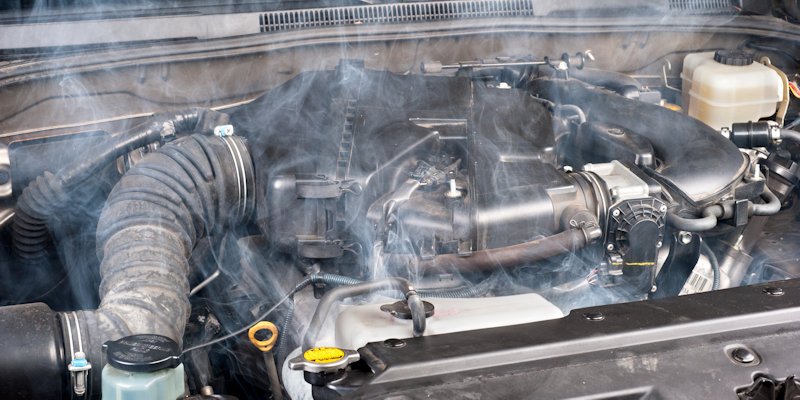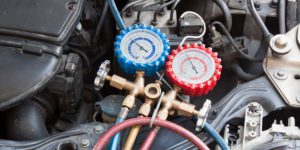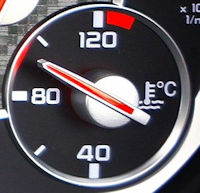
Crawford’s Auto Repair provides cooling system services, including everything from a cooling system flush to radiator repair. Vehicle owners in Chandler, Gilbert, and nearby surrounding areas in Arizona will have easy access to the shop for these services.
Schedule An AppointmentIf your vehicle is due for cooling system maintenance or if any of your dashboard lights or gauges are indicating that your engine is overheating, then bring your vehicle to Crawford's Auto Repair today. Get affordable 5-star service. Call 480-201-0740 to schedule an appointment.
A cooling system is needed to dissipate excess heat created during the internal combustion process. An automobile essentially contains a series of contained explosions which drive pistons up and down. This movement is eventually transferred through the transmission to the wheels to drive the vehicle forward.
The internal combustion process creates heat; heat is also created by rapid movement of part surfaces crossing over each other in both the engine and transmission. One way the heat is reduced is through proper use of lubrication and that’s what engine oil is for, as well as transmission fluid. But those are not sufficient on their own to reduce the heat that is created, so the cooling system provides a means to disperse excess heat away from the source to prevent damage. It does this with a flow of coolant, which is a specialized type of fluid made to capture and release heat. The coolant travels through channels near where the heat is, captures the heat, then travels to the radiator where the heat is released.
There are also air-cooled engines which do not use coolant. They have a fan to force air flow over the surface of the engine to remove heat. Air cooled engines are not as common in automobiles but they do exist, which is why the term “liquid cooled engine” also exists to identify engines that use coolant. Do you remember the lines from the movie Cars 2 when Finn McMissile first meets Holley Shiftwell? As a spy code Holley says, “A Volkswagen Karmann Ghia has no radiator”. To which McMissile replies, “that’s because it’s air cooled”. Well, now you at least have an idea of what the heck they were talking about!
The major components of the cooling system are the radiator, coolant, water pump, and thermostat. It also includes other parts such as the hoses and overflow reservoir. More details follow which describe the maintenance and repairs of these parts and the overall system. For an alternate description of the cooling system go to Lesson 6: The Cooling System from our Beginner’s Guide To Auto Maintenance & Repair online or download the ebook for free.
“Cooling System” Disambiguation: Among mechanics, technicians and other professionals, the “cooling system” is always understood as the system which cools the engine. However, the laymen could theoretically confuse this with the air conditioning system which helps to cool the driver and passengers in the cab. The cooling system and air conditioning are two completely separate and distinct systems. Yet, there are some components that are shared between them. One is that the AC compressor and the water pump (which is part of the cooling system) often share a serpentine belt; so if the belt fails then both systems can fail at the same time. Another shared component is that some coolant is channeled through the heater-AC unit. Incidentally, if your engine starts to overheat then one of the steps you can take is to turn off the AC and even turn on the heater. This may seem counterintuitive to turn on the heat when the engine is overheating, especially in the hot Arizona weather, but it redistributes the available coolant back to the engine. See also Free AC Check and AC Services.
Cooling System Maintenance
Checking the level and condition of the coolant is part of every standard maintenance check. Standard maintenance checks are performed with every oil change (about every 5,000 miles), as well as landmark mileage checks at 30,000, 90,000 and 150,000 miles. The technician also performs a visual inspection of the cooling system, as well as a tactile inspection of all soft parts of the vehicle under the hood, such as radiator hoses.
Note: If you are checking the coolant or topping it off at home, do not touch or open the radiator cap while the engine is hot. Boiling coolant can spew out and burn you.
Besides standard inspections, a cooling system flush at the proper mileage is also a standard maintenance service, depending on your make and model. We prefer to call this a “service” since it is more than just a flush. This is described in more detail below.
Cooling System Flush (ie. Cooling System Service)
A cooling system flush is often indicated at certain mileage for your vehicle depending on the make and model of the vehicle. The best reference to know when you might need one is the vehicle owner’s manual. Often a cooling system flush is due at 150,000 miles, although your make and model could be different, and in certain cases the system could need to be flushed before that.
A cooling system flush is part of standard maintenance because the system can become contaminated over time through a process of electrolysis, which is the breakdown of metals that occurs inside the engine block. A flush is also indicated whenever a standard maintenance check reveals that the coolant is low or dirty.
Coolant can get dirty when non-distilled water is mixed with it. The impurities in the water cause corrosion (breakdown of the metals in the engine) which collects with coolant. This can clog radiator and cooling passages. That’s why coolant is mixed with distilled water where these impurities are absent.
Some interpret the word “flush” as just draining coolant from the system. Yet, if a mechanic ever did this then it would be for a purpose, and there is much more involved, so “flush” might be an inadequate word. That’s why we prefer to call it a “Cooling System Service” or “Cooling System Fluid Service”. Between other shops and even customers, the phrases “cooling system service” and “cooling system flush” are often used interchangeably. This can become confusing when you’re looking for general cooling system “services” and repairs, or a list of services related to the cooling system. In those cases it helps to make a clear distinction between the plural “services” and the singular “service”, which means the flushing service. (If a technician is “servicing” the radiator or cooling system then it likely includes a flush but it may still be best to get clarification. We’re happy to answer any questions you may have).
Here is the service described in more detail. By including this here we are emphasizing that it is more than just a flush:
- Refer to the owner’s manual for locations of each part of the cooling system
- Open the radiator drain to drain the cooling system and collect the drainage into a container (this is delivered to a collection agency to be recycled)
- Remove the thermostat. The thermostat is typically on the engine side of the upper radiator hose, but in some cases it’s on the lower hose.
- Disconnect the lower radiator hose, force coolant through the thermostat housing (upper hose and engine block) with a water hose until the water runs clear
- Connect the water hose to the radiator, flush water through the radiator until the water runs clear.
- Completely drain the cooling system of all the water.
- Reinstall the thermostat
- Disconnect the reservoir and flush with water hose until water runs clear. Completely drain reservoir.
- Connect the cooling system hoses and close the drains.
- Fill the cooling system with new coolant to manufacturer’s specification and distilled water. Use a 50/50 mixture of coolant and distilled water or pre-mixed coolant.
As you can see, it’s more than just removing a plug and refilling the system. The cooling system flush is often combined with repairs, or it may involve the replacement of hoses. Any time the cooling system is opened and put back together we pressure test it to check for any leaks. This is also part of the “service”.
Flushing the cooling system will not correct an overheating concern. If your vehicle is overheating (as indicated on the temperature gauge on the dash or a dashboard indicator light), it would need to be diagnosed and repaired. Yet a flush would be part of the repair.
Cooling System Pressure Test

For more details on this test see How to Pressure Test The Cooling System.
What Do I Do If My Engine Overheats While I’m Driving?
If the engine begins to overheat while you’re driving then you might notice the temperature gauge pointing to hot and/or the temperature light will illuminate.
Engine Temperature Gauge
Your vehicle likely has a temperature gauge, when the dial gets to the red zone it means pull over safely and let the engine cool. The engine temperature light will also illuminate.
Engine Temperature Light
This warning light is one of at least four that we suggest vehicle owner’s should memorize so that you know what to do when it happens. It is supposed to be a thermometer in coolant, but if it helps you remember, it also looks like a sail boat.
Just like when the temperature gauge gets to the red zone, if this light illuminates you should pull over safely as soon as possible and let the engine cool. The longer it runs while overheating the more damage will be done and the more costly the repairs will be. Prolonged driving could damage the engine enough so that it can’t be repaired. Don’t let it get to that point. (If this symbol is blue, don’t worry about it).
You might be able to buy yourself a little time by turning on the heater which diverts some coolant back to the engine. This will help if you need the extra time to change lanes and get out of traffic.
Once you pull over safely then you’ll need to figure out a way to get your vehicle to the shop. If you don’t have other options, you can wait for the engine to cool and try adding coolant (or just water if that’s all you have) to the radiator. Do NOT open the radiator while the engine is hot! After adding the coolant and/or water, the engine might start and you can drive directly to a shop, but if the temperature gets too hot again you’ll need to pull over to let it cool again. This is not a practice you should repeat over and over again. It’s just to get you to the shop. It is best to have the vehicle towed to the shop.
Low Coolant Level Light
In addition to an engine temperature light you might also have a low coolant light. This light means your coolant is getting low and this should be serviced as soon as possible. You don’t have to pull over unless the temperature light above is also on, but this light should not be ignored for very long, and simply topping off the coolant (when the engine is cool) is not a sufficient fix. This light often means there is a leak, and the leak needs to be fixed.
Failing Cooling System Signs Which Merit Inspection and Repairs
The following symptoms indicate a need for further inspection and repairs:
- Engine is overheating, either smoke is visible or the dashboard temperature light and gauge indicate the engine is running hot
- Low coolant level light is illuminated
- Orange or green fluid discovered below your vehicle
- Vehicle has a sweet smell under the hood, like maple syrup
- You have to frequently top off the coolant
- Low coolant level or coolant leaks detected upon inspection. If the engine is hot then hot coolant could be spewing from the source of the leak. Be cautious not to burn yourself.
- Heater isn’t working (could also indicate other issues)
- Transmission isn’t shifting properly (could also indicate other issues)
- If your vehicle has a serpentine belt you could also have issues with the air conditioning and battery recharging system (alternator)
Cooling System Repairs – Radiator Repair & More
The symptoms listed above indicate the need for inspection and cooling system repairs. The most common repair is a coolant leak repair (or cooling system leak repair). Leaks can occur at the water pump, heater core, hoses, radiator and at multiple locations throughout the engine. There might be a bad head gasket or radiator cap.
After leaks the next most common issues with the cooling system include a failed thermostat, for which you’d need a thermostat replacement, a failed water pump for which you’d need a water pump replacement, and a failed radiator fan for which you’d need a radiator fan motor replacement.
If the radiator has an external clog then the grate can usually be cleaned with a pressure wash or air pressure. If the radiator has an internal clog, which blocks the proper flow of coolant, then you could need an entire radiator replacement.
The following is a more complete list of cooling system services:
- Overheating engine inspection
- Temperature Warning light inspection
- Hot temperature gauge inspection
- Coolant leak inspection
- Thermostat inspection with infrared light
- Air bleed housing assembly replacement
- Coolant reservoir replacement
- Coolant recovery reservoir replacement
- Coolant temperature switch sensor replacement
- Cooling system flush
- Radiator fan motor replacement
- Heater bypass tube replacement
- Coolant level sensor replacement
- Low water sensor replacement
- Coolant temperature switch (sensor) replacement
- Cooling system pressure test
- Radiator cap pressure test
- Radiator flush
- Radiator replacement
- Radiator repair
- Thermostat replacement
- Head gasket replacement
- Auxiliary water pump replacement
- Water pump pulley replacement
- Water pump replacement
- Radiator hose replacement
Crawford’s Auto Repair offers a free code scan and affordable inspections. Bring your vehicle to the shop and we can help you identify which repairs you need if any, especially if you have any dashboard indicator lights illuminated.
Call 480-201-0740 To Schedule Cooling System Services Today
If your engine is overheating and needs repairs or if you’re due for cooling system maintenance then bring your vehicle to Crawford’s Auto Repair. We don’t pay our staff with commissions and we never try to sell unnecessary repairs. Quality You Can Trust! Call 480-201-0740 to schedule an appointment today.



No Comments
Sorry, the comment form is closed at this time.